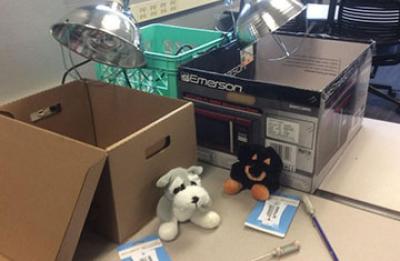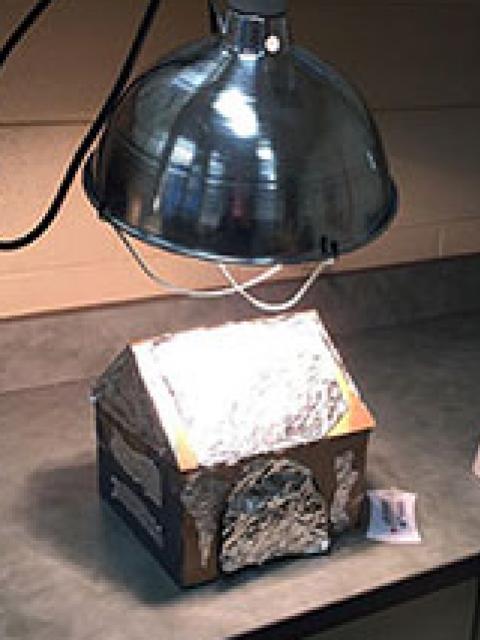Cool Puppy Doghouse: Project Overview

Submitted by: Cynthia Dickman; Brett Doudican; Raseena Jacob; Linda Gillum, RET Program, Universities of Central State, Dayton, and Wright State in Ohio
- Equipment Used: Power Tools, Hand Tools, General Fabrication Lab Equipment
- Time Required: 2 hours, dependent upon level, scale, constraints
Students are given the engineering challenge to design and build doghouses that shelter a toy puppy from the heat, and to create the shelter within material, size and cost constraints. Students research or apply what they know about light energy and how it does or does not travel through various materials. Students also learn how a material’s color affects its light absorption and reflection properties. Students build doghouse designs and test them by taking thermometer readings under hot lamps and then think of ways to improve their designs through iteration.
Scenario, Criteria and Constraints
One day after school, you went for a walk around your neighborhood and found a lost puppy! The puppy had no collar or tag, so you decided to take matters into your own hands. You rescued this lost puppy from the side of the road, but your mom is not willing to have your puppy in the house. The weather prediction is for a record-setting heat wave, and you are worried about your puppy being outside in the heat, so you decide to build a doghouse to Choose what materials you want to use to design and build the coolest doghouse for your puppy! From your saved allowances, you have $12 to spend. (Teacher: Adjust the amount and material, as appropriate.) Now you must carefully spend your savings to buy materials to create this doghouse!

- All supplies used must be purchased within a $12 budget.
- A budget tracking report must be provided prior to testing.
- The doghouse must protect the puppy from the outside heat.
- The doghouse temperature must stay under 32℃ (90℉) when out in the “sun” for 30 minutes.
- The doghouse must be a self-supporting structure.
- The dog must fit completely inside the doghouse.
- The dog must be able to exit the doghouse for access to a water dish.
Handouts
Materials
- One toy dog, such as a 6x6-inch stuffed or plastic toy, to which students refer when designing, measuring, “buying” supplies, constructing the doghouse. A bigger toy dog increases the amount of supplies needed.
- Markers, crayons, colored pencils, and colored paper.
- An assortment of building supplies, such as Styrofoam, aluminum foil, paper, saran wrap, plastic bottles, cardboard, construction paper, straws, bubble wrap, felt squares, toilet paper rolls, foam plates and cups, foam squares, foam board, newspaper, craft sticks, mylar, etc.
- An assortment of adhesives and tools, such as white glue, hot glue, tape, and scissors.
- Light/heat sources for testing, one for each doghouse, such as a 250-watt full spectrum heat lamp that is UL approved.
- Bigger boxes, into which the doghouses are placed, to help concentrate the heat. This is optional.
- Numerous room thermometers. Each doghouse test requires two thermometers, for inside and outside the doghouse.
- Timer, to time 30 minutes.
Learning Outcomes
While completing this activity, students will learn about light and heat, including:
- Absorption
- Energy transfer
- Insulation and material properties




